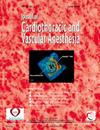Ipsilateral High Thoracic Ultrasound-Guided Erector Spinae Plane Block for Post-Thoracotomy Shoulder Pain in Thoracic Cancer Surgeries: A Randomized Controlled Clinical Trial
IF 2.1
4区 医学
Q2 ANESTHESIOLOGY
Journal of cardiothoracic and vascular anesthesia
Pub Date : 2025-07-25
DOI:10.1053/j.jvca.2025.07.034
引用次数: 0
Abstract
Objectives
To assess the safety and efficacy of ultrasound-guided high thoracic erector spinae plane block (HT-ESPB) in the management of post-thoracotomy ipsilateral shoulder pain (PTISP).
Design
Randomized, double-blind, parallel-group, controlled, clinical trial.
Setting
The National Cancer Institute.
Participants
Seventy-six adult patients undergoing thoracic cancer surgery.
Interventions
Patients were randomized into two equal groups: A control group received thoracic epidural analgesia (TEA) alone (TEA group), and a study group received ultrasound-guided HT-ESPB plus TEA (ESPB group).
Measurements and Main Results
Outcomes included the incidence of PTISP, time to first rescue analgesia and total rescue analgesic doses for ISP, intraoperative fentanyl consumption, heart rate, mean arterial pressure, oxygen saturation, and complications. The ESPB group had a significantly lower incidence of ISP in the first postoperative hour compared to the TEA group (60.5% v 97.4%, p < 0.001). The ESPB group also exhibited lower postoperative visual analog scale scores, longer time to first rescue analgesia, and a reduced number of rescue analgesic doses for ISP, as well as lower heart rate and mean arterial pressure. No significant complications were reported.
Conclusions
Ultrasound-guided HT-ESPB is a safe and efficacious strategy for the management of PTISP. It demonstrated a significant reduction in the incidence and severity of ISP and postoperative analgesic requirements when compared to TEA alone. This approach enhanced hemodynamic stability without significant complications.
同侧高胸廓超声引导直立者脊柱平面阻滞治疗胸癌手术后肩部疼痛:一项随机对照临床试验。
目的:评价超声引导下高胸直肌脊柱平面阻滞(HT-ESPB)治疗开胸术后同侧肩痛(PTISP)的安全性和有效性。设计:随机、双盲、平行组、对照临床试验。地点:美国国家癌症研究所。参与者:76例接受胸部肿瘤手术的成年患者。干预措施:将患者随机分为两组:对照组(TEA组)单独行胸椎硬膜外镇痛(TEA),研究组(ESPB组)行超声引导下HT-ESPB加TEA。测量方法及主要结果:结果包括PTISP发生率、首次抢救镇痛时间、ISP抢救镇痛总剂量、术中芬太尼用量、心率、平均动脉压、血氧饱和度、并发症。ESPB组术后1小时ISP发生率明显低于TEA组(60.5% vs 97.4%, p < 0.001)。ESPB组也表现出较低的术后视觉模拟量表评分、较长的首次抢救镇痛时间、较少的ISP抢救镇痛剂量、较低的心率和平均动脉压。无明显并发症报道。结论:超声引导下HT-ESPB治疗PTISP是一种安全有效的治疗策略。与单独使用TEA相比,它证明了ISP的发生率和严重程度以及术后镇痛需求的显著降低。该入路增强了血流动力学稳定性,无明显并发症。
本文章由计算机程序翻译,如有差异,请以英文原文为准。
求助全文
约1分钟内获得全文
求助全文
来源期刊
CiteScore
4.80
自引率
17.90%
发文量
606
审稿时长
37 days
期刊介绍:
The Journal of Cardiothoracic and Vascular Anesthesia is primarily aimed at anesthesiologists who deal with patients undergoing cardiac, thoracic or vascular surgical procedures. JCVA features a multidisciplinary approach, with contributions from cardiac, vascular and thoracic surgeons, cardiologists, and other related specialists. Emphasis is placed on rapid publication of clinically relevant material.

 求助内容:
求助内容: 应助结果提醒方式:
应助结果提醒方式:


